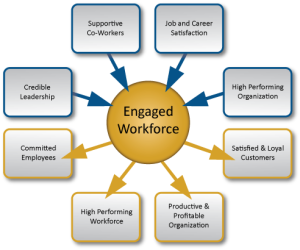
The practice of mindfulness meditation is gaining popularity in the business world. Celebrities swear by it, politicians practice it, and businesses use it to prevent burnout. Why?
Work can be a stressful place, and with companies trying to keep an eye on the bottom line while simultaneously improving productivity, many workers may find themselves with more responsibilities than ever before. While there is no way to totally eliminate stress from the workplace, some companies are doing what they can to help employees relax. Mindfulness has gained interest because it allows us to better manage stress and anxiety. Furthermore, it has quickly become a tool within businesses to increase the productivity and well-being of employees.
What is Mindfulness?
Mindfulness is not a new idea. The concept can be traced back to the fifth century BC. Mindfulness is a practice involved in various religious and secular traditions—from Hinduism and Buddhism to yoga and, more recently, non-religious meditation. People have been practicing mindfulness for thousands of years, whether on its own or as part of a larger tradition.
So what exactly is mindfulness? Simply, mindfulness is meditation. It’s an  ancient Buddhist practice which is about paying attention in a particular way, in the present moment, on purpose and non-judgmentally. According to Dr. Jon Kabat-Zinn, professor of medicine emeritus at the University of Massachusetts Medical School, mindfulness is the art of being in the “now”—living fully in the present. It focuses on becoming fully aware of one’s thoughts and feelings and accepting them, but not attaching or reacting to them. With mindfulness, there is no “right” or “wrong” way to think or feel in any given moment.
ancient Buddhist practice which is about paying attention in a particular way, in the present moment, on purpose and non-judgmentally. According to Dr. Jon Kabat-Zinn, professor of medicine emeritus at the University of Massachusetts Medical School, mindfulness is the art of being in the “now”—living fully in the present. It focuses on becoming fully aware of one’s thoughts and feelings and accepting them, but not attaching or reacting to them. With mindfulness, there is no “right” or “wrong” way to think or feel in any given moment.
Mindfulness has many positive benefits, including lowering stress levels, improving sleep and brain function, and protecting against depression and anxiety. Research even suggests that mindfulness can help people better cope with rejection and social isolation.
Companies and Politicians Practicing Mindfulness
A number of well-known companies are promoting mindfulness programs in the workplace including Google, Apple, Nike, University of Iowa Healthcare, Procter & Gamble, and Yahoo.
Even politicians are using mindfulness meditation in their approach to politics. For example, Ohio Congressman Tim Ryan is one of a growing group of prominent politicians incorporating mindfulness into their approach. Ryan has become an evangelist for meditation on Capitol Hill and is encouraging other lawmakers to try it. He’s securing federal funding for a pilot meditation program at schools in his district, and is even writing a book, “A Mindful Nation: How a Simple Practice Can Help Us Reduce Stress, Improve Performance, and Recapture the American Spirit.” And, he’s not alone.
Attorney General Eric Schneiderman to Bill Clinton and Republican lawmaker Mark Sanford are a growing number of politicians using daily mindfulness meditation.
Benefits of Mindfulness

Numerous clinical trials have shown the positive effect mindfulness has on the brain including wellbeing and happiness:
- Improves mood and levels of happiness and well-being1
- Reduces day-to-day anxiety and prevents and treats depression2
- Increases engagement in the workplace because mindfulness helps to create a positive culture at work. Absence levels are reduced and employee retention improves. Job satisfaction increases and productivity is higher.
- Supports a healthy work life balance—by paying attention to how things are and not judging things in any way can help you respond more effectively in all areas of your life.
Conclusion
Practicing mindfulness meditation helps to be more present, as well as less judgmental, more patient, and able to see things from a new perspective.
Not sure if mindfulness is right for you? Give it a try – you have nothing to lose and everything to gain.
Clinical Trials – Footnotes:
1Mindfulness and Mood Disorders in the Brain
2 Randomized Controlled Trial of Mindfulness Meditation for Generalized Anxiety Disorder: Effects of Anxiety and Stress Reactivity


 all the ways in which people differ and is an awareness of and respect for individuals with unique perspectives, backgrounds, and their attributes working towards a common goal. It’s about people.
all the ways in which people differ and is an awareness of and respect for individuals with unique perspectives, backgrounds, and their attributes working towards a common goal. It’s about people.

